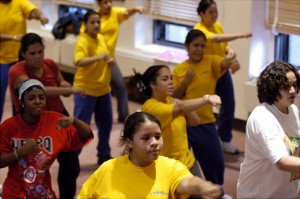 A few months of moderate aerobic exercise may not rev up obese teenagers’ ability to burn calories, even though it may increase thinner teens’ ability to burn dietary fat, new research suggests.
A few months of moderate aerobic exercise may not rev up obese teenagers’ ability to burn calories, even though it may increase thinner teens’ ability to burn dietary fat, new research suggests.
In a study of 28 obese and normal-weight teenagers, researchers found that after 12 weeks of treadmill and exercise-bike sessions, the heavier teens showed no changes in their bodies’ calorie- and fat-burning throughout the day.
Their thinner peers likewise showed no changes in daily calorie expenditure. However, their dietary-fat metabolism did increase, on average.
The findings, reported in the American Journal of Clinical Nutrition, do not mean obese kids should throw in the towel on exercise, given previous research.
In an earlier study of the same workout regimen, the researchers found improvements in obese teenagers’ sensitivity to the blood-sugar-regulating hormone insulin; decreased insulin sensitivity often occurs before type 2 diabetes.
The teens also showed reductions in the deep layers of abdominal fat that surround the organs — the body fat that is considered especially important in the risk of diabetes and other health problems.
So together, the findings suggest that obese teenagers can get “important health benefits” from aerobic exercise even without changes in their calorie and fat metabolism, according to Dr. Agneta L. Sunehag, an associate professor of pediatrics at Baylor College of Medicine in Houston and the lead researcher on the new study.
In an email, she also pointed out that the study looked at one moderate-exercise regimen alone; the participants did not alter their eating habits or lose weight. It’s possible, Sunehag said, that exercise along with weight loss would affect obese teens’ metabolism.
It’s a common perception that exercise not only burns calories during the workout, but also leads to lasting changes in a person’s metabolism at rest. However, studies suggest that any effects may depend on the type and intensity of exercise, and on a person’s body composition.
Recent research has found, for example, that a few months of strength training may increase resting metabolism and daily calorie- and fat- burning in overweight women. Another study found that any exercise — strength training or aerobic — was related to a higher resting metabolism in women, but only for those who regularly worked out at a high intensity.
Until now, though, little has been known about the effects of exercise on obese teenagers’ calorie- and fat-burning, Sunehag said.
The study included 15 obese and 13 normal-weight Hispanic-American teenagers who completed a 12-week exercise program — walking on a treadmill or using an exercise bike for 30 minutes, four times per week.
At the beginning and end of the study, the researchers measured the teens’ total calorie expenditure over 24 hours. Each participant stayed in a room where a device measured their oxygen consumption and carbon dioxide production; that allows researchers to estimate a person’s calorie expenditure, as well as the proportions of fat, carbohydrates and protein they are burning.
In general, neither obese nor normal-weight teenagers showed changes in their overall calorie expenditure at the end of the study, but the thinner teens did show an increase in fat burning.
The reason for that discrepancy is not clear, according to Sunehag’s team, but studies of adults have had similar findings. One possibility, the researchers suggest, is that obese teenagers have an “impaired metabolic flexibility” that blunts their fat-burning response to exercise.
Leave a Reply